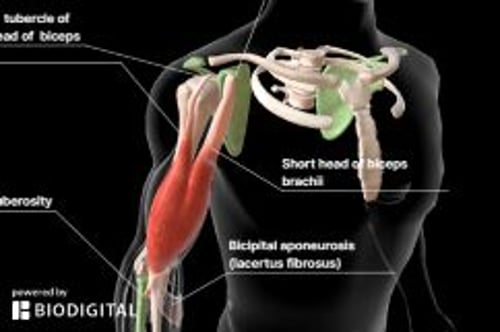Biceps tendon tears can involve the tendon attachment at the shoulder or the elbow. Sharp pain occurs at the site of the tear. Surgical repair is usually required.
(See also Overview of Sprains and Other Soft-Tissue Injuries.)
The biceps muscle has two tendons that attach proximally to the scapula (supraglenoid tubercle and coracoid process of the shoulder) and one tendon that attaches distally to the radius at the elbow (radial tuberosity). Proximal biceps tendon tears are more common than distal biceps tendon tears.
Biceps tendon tears are caused by a sudden forceful event (eg, lifting a heavy object) or forceful extension or twisting of the elbow. These tears typically occur when the tendon is already weakened by overuse (eg, as occurs with weightlifting), which can cause tendinitis and sometimes fraying of the tendon. In older patients, degenerative tendinosis, which weakens the biceps tendons, increases the risk of a tear. Other factors that can weaken a tendon may increase risk of tendon tears, but their contribution to biceps tendon tears has not been well-studied.
The injury that tore the biceps tendon may also damage other structures in the shoulder (eg, rotator cuff).
Biceps tendon tears may be partial or complete.
Symptoms and Signs of Bicep Tendon Tears
Biceps tendon tears cause sudden, severe pain either at the upper arm and shoulder or near the elbow, depending on the location of the tear. Pain is worsened by lifting or pulling. Other symptoms include bruising, swelling, and weakness. Also, the detached muscle may form a bulge in the arm (Popeye deformity).
Diagnosis of Bicep Tendon Tears
Clinical evaluation
Ultrasonography
MRI
Biceps tendon tears can often be diagnosed based on the history and a physical examination. The examination and special tests (eg, hook test) can suggest which tendon is injured and whether the tendon is torn. For the hook test, the flexed elbow is supinated, and examiners attempt to hook their index finger under the intact biceps tendon from the lateral side. If the biceps tendon is torn (distal avulsion), there is no cordlike structure to palpate or hook.
© Springer Science+Business Media
Musculoskeletal ultrasonography is often used to examine the shoulder and is accurate for diagnosis of complete proximal biceps tendon tears. Ultrasonography is less useful for partial tears and distal biceps tendon tears.
MRI may confirm the diagnosis but is usually not needed.
Treatment of Bicep Tendon Tears
Usually surgical repair
Treatment of distal biceps tendon tear is usually surgical repair as soon as possible.
Proximal biceps tendon tears are sometimes managed conservatively because if one of the two biceps tendons at the shoulder is intact, that tendon can maintain function.
However, surgery is often needed for repair of proximal tendon tears, especially when there are other shoulder injuries.

